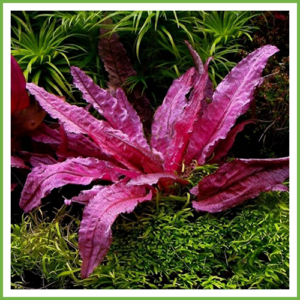Description
Echinodorus Uruguayensis


Overview
Echinodorus uruguayensis, commonly known as the Uruguay sword plant, is a popular freshwater aquarium plant valued for its lush, green, ribbon-like leaves. Native to South America, particularly the Uruguay River basin, it belongs to the Alismataceae family. This robust, fast-growing plant is ideal for midground or background placement in aquariums due to its size and aesthetic appeal. It can grow up to 24 inches (60 cm) tall and 12 inches (30 cm) wide, creating a striking focal point in planted tanks.
Care Requirements
Lighting: Moderate to high lighting (50–70 µmol PAR) promotes healthy growth and vibrant leaves. Low light may result in slower growth and smaller leaves.
Water Parameters:
- Temperature: 20–28°C
- pH: 6.5–7.5
- Hardness: Soft to moderately hard (3–15 dGH)
Substrate: Nutrient-rich substrate (e.g., aquasoil or gravel with root tabs) is essential, as Echinodorus uruguayensis is a heavy root feeder.
Nutrients: Requires regular fertilization with liquid fertilizers (rich in iron, potassium, and micronutrients) and root tabs for optimal health.
CO2: Not strictly necessary, but supplemental CO2 (10–20 ppm) enhances growth and leaf size.
Tank Requirements: Minimum 80 litres for smaller specimens; larger tanks (160+ litres) are better for mature plants due to their size.
Planting and Propagation
Planting:
- Plant the roots deeply in the substrate, leaving the crown (where leaves emerge) exposed to prevent rot.
- Use a substrate at least 4–5 cm deep to accommodate the extensive root system.
- Space plants 15–20cm apart to allow room for growth.
Propagation:
- Echinodorus uruguayensis propagates primarily through adventitious plantlets that form on flower stalks (inflorescences).
- When plantlets develop roots and leaves, gently detach them and plant them in the substrate.
- Alternatively, divide the rhizome of a mature plant, ensuring each section has roots and leaves, and replant.
- Under good conditions, the plant may produce runners with plantlets that can be separated and replanted.
Maintenance
- Pruning: Trim dead or yellowing leaves at the base to maintain appearance and encourage new growth. Remove excessive runners to control spread.
- Fertilization: Add root tabs every 2–3 months and dose liquid fertilizers weekly, adjusting based on plant response.
- Water Changes: Perform regular water changes (25–50% weekly) to maintain water quality and prevent nutrient imbalances.
- Cleaning: Gently rinse leaves during maintenance to remove algae or debris, taking care not to damage them.
- Monitoring: Watch for signs of nutrient deficiency (e.g., yellowing leaves indicate nitrogen or iron deficiency) and adjust fertilization accordingly.
Challenges and Tips
Challenges:
- Nutrient Deficiencies: Pale or yellow leaves often indicate insufficient iron or nitrogen. Use iron-rich fertilizers or root tabs to address this.
- Algae Growth: Excessive light or nutrient imbalances can lead to algae on leaves. Reduce light duration (8–10 hours/day) or adjust nutrient dosing.
- Melting: New plants may experience leaf melting when adapting to new tank conditions. Maintain stable parameters to minimize stress.
- Size Management: Rapid growth can overcrowd smaller tanks. Plan tank layout to accommodate its mature size.
Tips:
- Pair with fish like tetras or corydoras that won’t disturb the roots. Avoid aggressive fish (e.g., cichlids) that may uproot the plant.
- Use a substrate barrier (e.g., mesh) to prevent fish or strong water flow from disturbing the roots.
- If CO2 injection is unavailable, consider low-tech alternatives like liquid carbon supplements.
- For vibrant growth, ensure consistent lighting and nutrient schedules.
Recommendation
- Aquarium Setup: Ideal for medium to large planted tanks with nutrient-rich substrates. Combine with smaller foreground plants (e.g., Cryptocoryne or Anubias) for a balanced aquascape.
- Compatibility: Suits community tanks with peaceful fish and invertebrates. Avoid pairing with herbivorous species like silver dollars that may eat the leaves.
- Beginner Suitability: Moderately easy to grow, making it suitable for intermediate aquarists. Beginners may need to invest in proper lighting and fertilization.
- Aesthetic Use: Place in the midground or background to create depth. Its flowing leaves complement driftwood or rock hardscapes.







